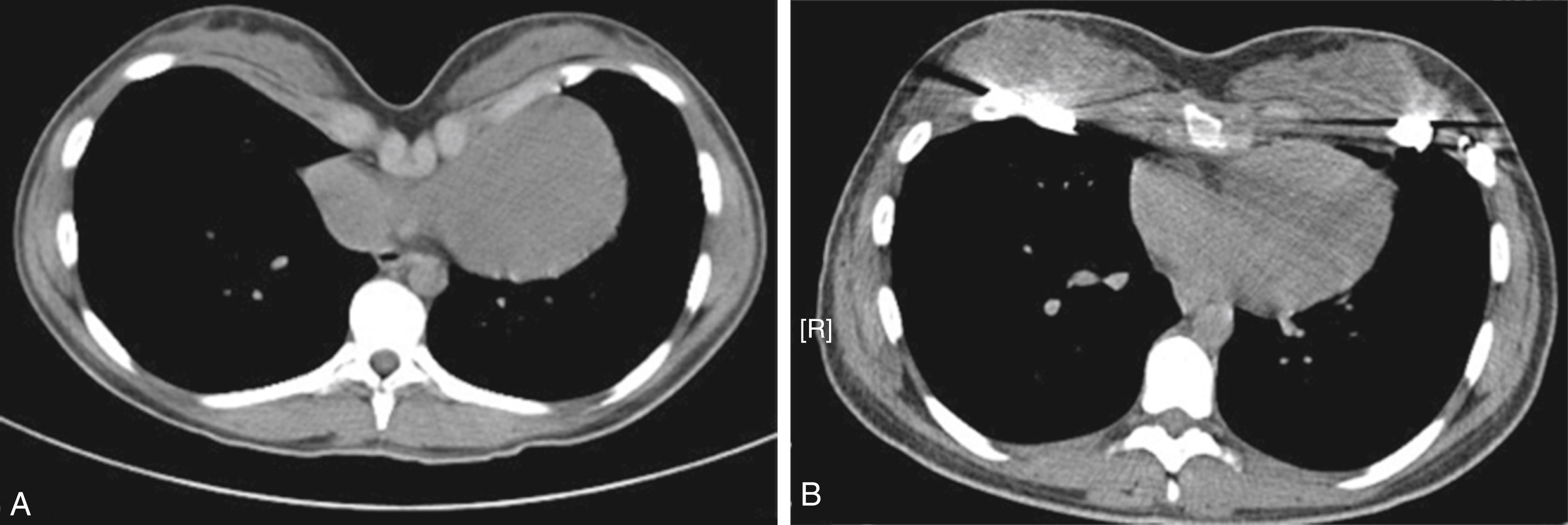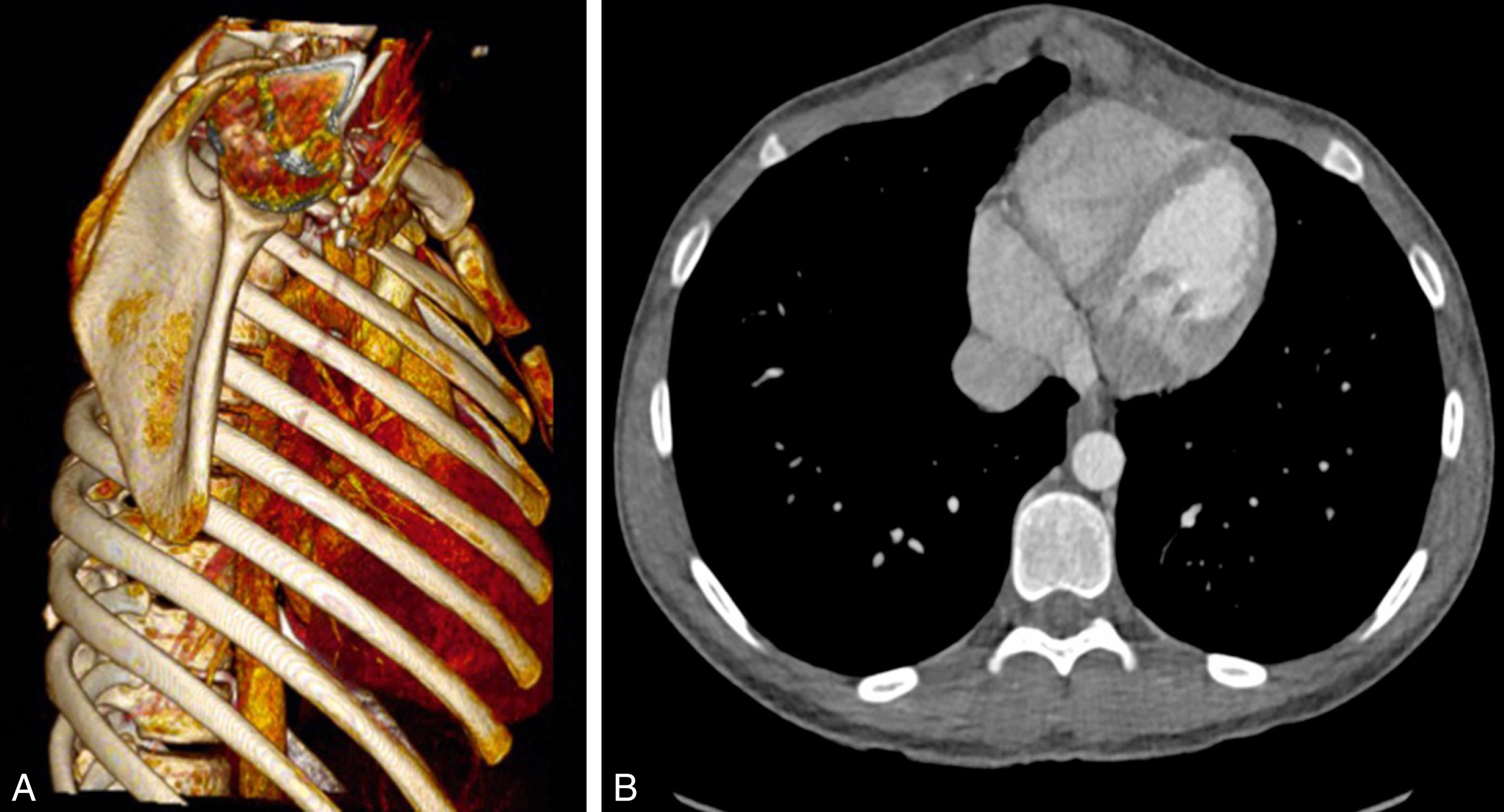Physical Address
304 North Cardinal St.
Dorchester Center, MA 02124
The thoracic cage serves two principal functions: to protect the thorax and upper abdomen and their associated viscera, and to allow movement for ventilation. It consists of 12 pairs of ribs and their respective costal cartilages; the manubrium and sternum anteriorly, and the thoracic vertebrae posteriorly. The costal cartilages of the true ribs (1–7) articulate directly to the manubrium/sternum. The costal cartilages of the false ribs (8–10) unite as a single synchondrosis and join the costal cartilage of the 7th rib. The floating ribs (11 and 12) have no anterior articulation. Three layers of intercostal muscles exist between each rib (external, internal, and innermost) and a neurovascular bundle (artery, vein, nerve) runs in a groove below each rib between the internal and innermost layers of muscle. The thorax is defined inferiorly by the diaphragm and superiorly by the clavicles.
Congenital chest wall anomalies may present at any age up to adolescence and may occur in isolation, or represent one marker in a spectrum of defects.
In this spectrum of malformations, there is an abnormal contour of the anterior chest wall. It is thought the underlying problem lies with the relative rate of growth of the costal cartilages in relation to the growth of the ribs and sternum. If the elongated cartilages cause the anterior chest wall to buckle inwards, pectus excavatum results. If there is buckling outwards, the result is pectus carinatum. However, some have proposed that the defects arise from abnormal growth of the diaphragm.
Both conditions may be symmetric or asymmetric in nature, with a varying composite of anomalies, such as sternal angulation, tilt, and rotation about the long axis – all of which need to be taken into account during cosmetic correction. Within the broad spectrum, some patients may even have a mixed defect.
In this condition, there is a depression in the anterior of the chest wall of varying shape and severity ( Fig. 39.1 ).

In most cases, the depression is symmetrical on either side of the midline and limited to the lower half of the sternum. More severe forms are deeper and extend further upwards toward the manubrium. At the more severe end of the scale is the so-called “Grand Canyon” variety where there is a deep and long depression. It can be a challenge to treat successfully, particularly since many of these are asymmetrical. In about 5% of cases, there is a combined excavatum/carinatum deformity.
The incidence of the defect is 1 in 150–1000 live births. Although the defect may be present anytime after birth, most patients present around the time of puberty during their phase of rapid body growth. There is also an association with connective tissue disorders such as Marfan’s and Ehlers–Danlos syndromes where scoliosis is also more frequent.
Prior to surgical correction, we undertake a number of investigations to determine the severity and extent of morphology, as well as impact on physiology.
We routinely perform a plain chest radiograph that demonstrates the overall shape of the thoracic cavity. A plain chest radiograph is also a very useful screening tool to assess the spinal curvature initially.
This is followed by computerized tomography (CT scan) imaging, which can be used to construct the 3D anatomy of the thoracic cavity. The Haller index of severity can be calculated from this. This is the ratio of the transverse diameter and the anteroposterior diameter of the rib cage. A normal ratio is 2.5. Of special importance is the shape and axis of the body of the sternum. Sternal torsion and asymmetry have an impact on the type of surgery. CT scan can also show associated anomalies including spinal deformities and also the extent of cardiac compression.
We also routinely perform transthoracic echocardiography to assess overall ventricular function. There is an association with mitral valve prolapse, which may be seen with connective tissue disorders.
As part of our initial evaluation, we also perform exercise testing of the patient. This is following some reports of a modestly reduced functional capacity arising from the combination of right ventricular compression and reduced pulmonary capacity in some patients.
Lung function testing including spirometry becomes useful whenever a restrictive lung capacity is suspected. In combination with exercise testing, this offers a very useful physiological way to assess functional implication of the pectus deformities, and also serves as a prognostic index for postoperative recovery.
There are advantages and disadvantages to both early and late repair. Each case is considered individually. Important factors to consider include the age at presentation, symptoms, severity of the deformity, and type of surgical approach. As a general rule, younger patients have a more malleable chest, which will make the minimally-invasive Nuss procedure an attractive option here. However, it has to be tempered with the fact that some of these children will outgrow their bar and need further bar insertion. Also, early bar removal in younger patients may result in recurrence as the chest continues to remodel with age. Nevertheless, the severity will reduce the age at intervention.
In the literature, surgery has been performed successfully from the ages of 1 year to 50. , In our experience, for the reasons noted above, the ideal is around the age of puberty.
We reserve the minimally-invasive Nuss procedure for symmetric cases. If the symmetry extends to a so-called Grand Canyon-type deformity, we may either use two Nuss bars, or elect to perform an open sternochondroplasty. If it is likely that any second bar needs to be inserted high up, we favor an open approach due to the risk of placement over the great arteries in the mediastinum. In some cases with mild asymmetry, the Nuss bar can be molded appropriately.
The patient is usually positioned supine on the operating table with the arms abducted following induction of anesthesia and epidural catheter placement.
Once positioned, necessary landmarks are drawn on the chest – the deepest part of the chest that indicates the level where the bar will lie, the point beneath the nipples at the level of where the bar will lie, and the two lateral points where the vertical skin incisions are made for the introduction of the bar and stabilizers.
The two lateral skin incisions are made, and the subcutaneous plane is developed to the marked point beneath the nipples at the level of where the bar will lie. These will be the points at which the bar will exit the chest wall on either side. Then, the thoracoscope is introduced into the right pleura through a port placed either just beneath or into the lateral skin incision. Carbon dioxide insufflation permits exposure. Next, the bar introducer creates a subcutaneous tunnel from the skin incision to the point of entry into the chest. Entry through the chest wall is observed via thoracoscopy. The introducer is passed to the pleural cavity on the other side, anterior to the pericardium under direct vision. It is guided through the chest wall. Once safely out of the skin, it is tied by umbilical tape to a molded Nuss bar of appropriate size. As the introducer is removed, the bar is carried with it into the chest. The bar is then finally flipped with a specially-designed flipper and secured to the chest wall by bilateral stabilizers secured to it by steel wire (see Fig. 39.3B ).
Following the procedure, the patient is extubated on table and a chest radiograph is taken immediately to check for pneumothoraces and bar position.
Once on the ward, the patient is observed in the high dependency unit for the duration of the epidural catheter – usually 4–5 days. Adequate analgesia is very important here once the epidural is removed. Mobilization aided by physiotherapy is the final step before discharge. A final posteroanterior and lateral chest radiograph check the bar position.
We elect to remove the bar anywhere between 2 and 3 years. Although the bar can be left in for 4 years without problems, the longer it is left, the greater the degree of calcification around the bar, which can make removal more challenging. Removal is performed as a day-case procedure under general anesthesia. The greatest risk comes from pneumothorax, and there are also isolated reports of injury to great vessels.
This is also known as “pigeon” or “keel” chest. In this condition, there is variable protrusion of the chest. It is less common than pectus excavatum, being seen in about 0.06 of all live births ( Fig. 39.2 ).

Depending on the exact extent of the protrusion, there are a number of variations.
Symmetrical : The sternum is arched forwards. If there is some depression of the costal cartilages, the sternal prominence is exaggerated. In some cases, the body of the sternum fuses with the xiphoid at a 90-degree angle.
Symmetrical deformity with a normal sternum : here, the anterior prominence comes from protrusion of the costal cartilages with a relatively normal sternal contour.
Asymmetry with combined carinatum and excavatum : protrusion of costal cartilages on one side only causes rotation of the sternum about its long axis, causing a relative excavatum on the contralateral side.
Pouter pigeon chest : there is prominence of a thickened manubrium so that the deformity is limited to the upper sternum only.
Become a Clinical Tree membership for Full access and enjoy Unlimited articles
If you are a member. Log in here